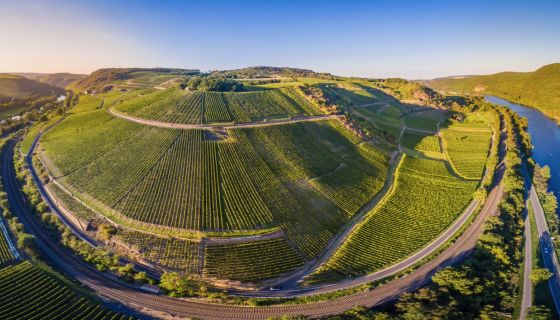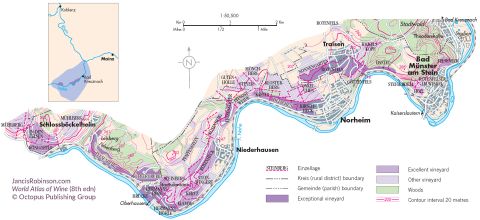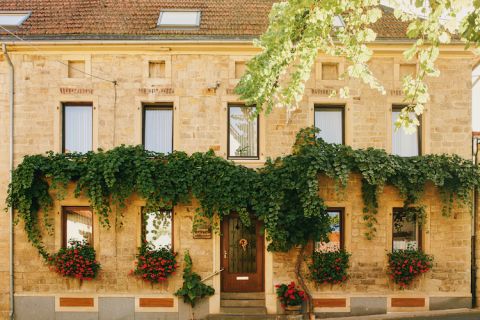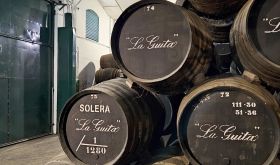From £23.20, $30.80, €36.90 (magnum in Germany)
Jakob Schneider may not be one of the best-known names in the Nahe – if you live outside of Germany – but perhaps it should be, if this excellent, pure, dry German Riesling is anything to go by.
The Schneider family are certainly not new to the Nahe region. They have been farming in the village of Niederhausen since 1575. For the first three centuries they ran a mixed farm, which was typical at the time. It wasn’t until 1901 that they sharpened their focus on steep-slope viticulture and making wines from their premium vineyard sites in Niederhausen and Norheim.
As you can see from the World Atlas of Wine map of part of the River Nahe below, the spectacular, south-facing Hermannshöhle vineyard, pictured above, lies on a bend in the river, the Riesling vines planted on grey slate and volcanic rocks that warm quickly in the sun, producing intense flavours and making the hard work of farming 18 hectares (44 acres) of such vineyards along the river worthwhile. 85% of their vines are Riesling.
The winery is run by Jakob Schneider Junior and his wife Laura, pictured below with their daughters Julia and Johanna, supported by Jakob’s parents. (I wonder how many Jakob Juniors and Seniors there have been since 1575?)
I tasted the 2020 a few weeks ago and was impressed by the wine’s intensity and incipient complexity, at a perfect moment in its evolution to enjoy both the crisp fruit purity and the first signs of bottle age – a hint of that slightly fumy/smoky aroma sometimes compared unflatteringly to kerosene. The alcohol is just 12.5% and the bottle is sealed with a screwcap, which means it is likely to age more slowly.
The fruit is so vibrant that I was not entirely sure if it was bone dry even if it is technically dry (ie trocken) according to German labelling regulations. In fact it has just 3 g/l residual sugar and a whopping but perfectly balanced 8.1 g/l of acidity. At the end of my tasting note, I concluded, ‘Long and mouth-watering and with the potential to gain further complexity over the next five years. But it is now in a perfect moment to enjoy the salty, stony but vibrant and intense citrus fruit.’ Tam tasted the same wine more than a year ago and scored it 17, as I did in July.
For a wine of such depth, made from such a demanding vineyard, it is unquestionably underpriced.
The vines are around 45 years old and are perforce hand-harvested. In 2020, a year marked by drought, and what Laura Schneider described as a ‘turbo harvest’ because many varieties ripened at the same time, the grapes were picked in mid October. Mid-summer temperatures late in the season encouraged growers to harvest at night or very early in the morning.
About half of the juice fermented spontaneously (ie without adding cultured yeast) in big, old oak casks (1,200-litre Stückfässer and 2,400-litre Doppelstückfässer up to 25–30 years old); the rest fermented with cultured yeast in stainless-steel tanks.
When I asked Laura Schneider why they chose to use both tank and cask for fermentation, she explained: ‘If you do spontaneous fermentation [for part of the wine], the style of wines out of stainless steel and wood are different. The wine out of wood is much more open, softer.’ The blend, she says, not without bias but convincingly, is ‘perfection’.
While there are some bottles of the 2020 available in the US (as per the Wine-Searcher link above), US importer Skurnik Wines have moved on to the 2022 vintage. So I asked Laura to send me a sample of this more recent release earlier this week.
Like 2020, 2022 was, according to the Schneiders, another warm vintage in the Nahe, with a very dry summer, leading to a steep rise in the sugar levels in the grapes. Heavy rain in early September – not normally relished – slightly increased the amount of juice in the grapes and brought down the sugar levels without bringing excessive risk of botrytis. Cool nights kept the wine fresh and the final alcohol level was once again a very digestible 12.5%.
While it doesn’t have any of the 2020’s bottle-aged complexity, it clearly has the potential to develop these characteristics if you can keep the wine somewhere cool for a least a couple of years. It has a similar marked intensity of fruit – mostly in the lemon-lime spectrum but perhaps a little riper and spicier than the 2020 – and a smoky/stony quality, which could be described as ‘minerality’. It’s powerful and pure and, like the 2020, has a long mouth-wateringly salty aftertaste. The residual sugar is a tiny bit higher (4 g/l) and the acidity roughly the same, resulting in excellent harmony.
If you need help in tracking down the wine in the US, email Gabriel Clary at Skurnik Wines. In the UK the 2020 is available from the Schneiders’ UK importer The Wine Barn.
Laura Schneider tells me that their wines are also available in Denmark (Jysk Vin), Belgium (Wijnhuis Tinto), the Netherlands (Wijn op Dronk), Czechia (Magnum Wines), Sweden (Vinunic), Norway (Vinetum) and Japan (Kespelher Wine Shippers).
For nearly 2,000 reviews of Nahe Rieslings from these and other vintages, search our tasting notes database. See also Paula’s recent comments on the Nahe in German new releases – summer 2023.


















